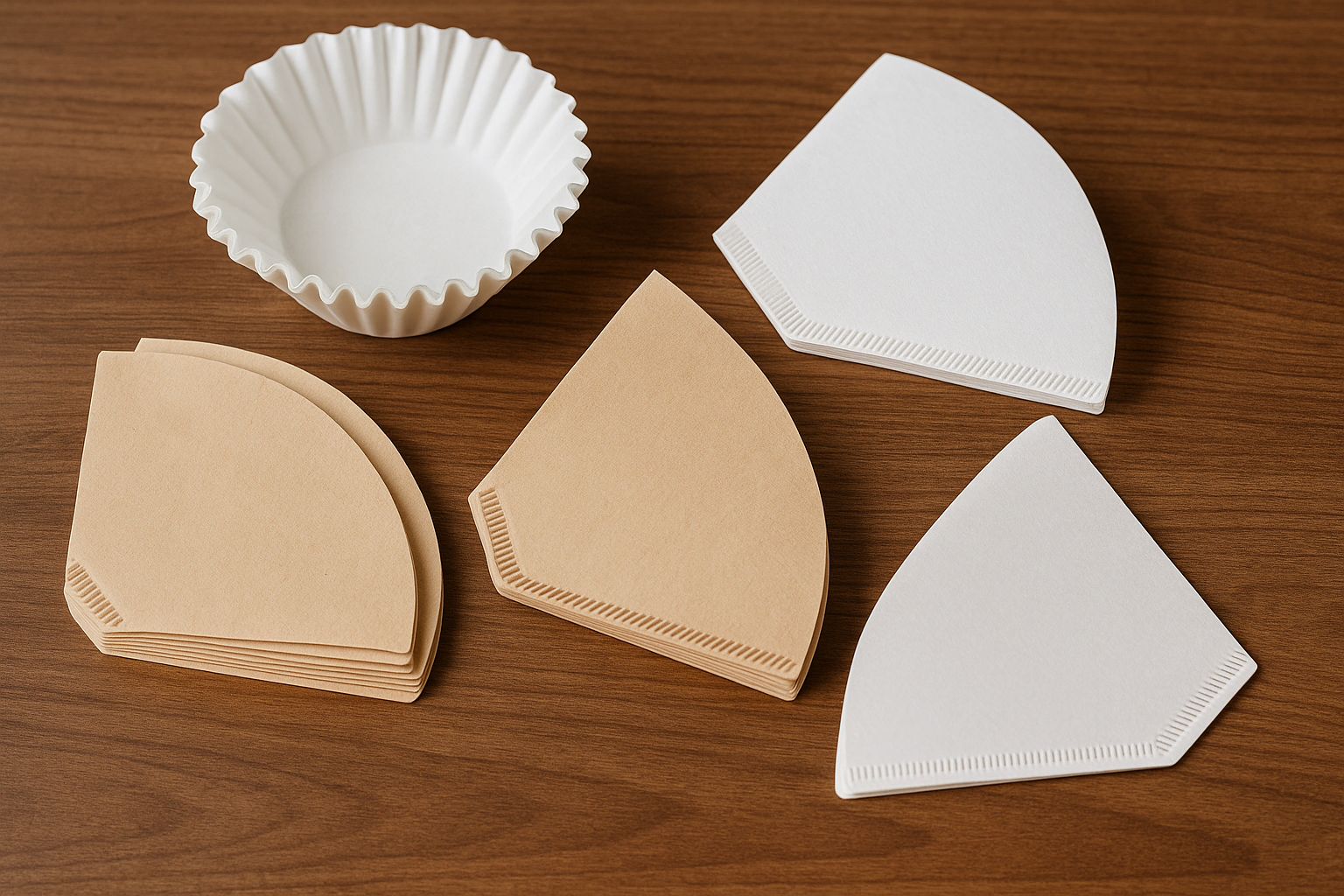Understanding how paper filters shape your coffee’s body and aroma can unlock new levels of flavor precision.
While often overlooked, the type, thickness, and pore size of your filter influence extraction by regulating the amount of oils and fine particles that reach your cup.
This guide dives deep into the factors that make each paper filter unique, how they affect taste, and tips to select and use them to craft your ideal brew.
The Role of Filters in Coffee Extraction
Every brewing method—pour-over, drip, Clever Dripper—relies on a filter to separate grounds from liquid. Beyond just trapping coffee particles, paper filters:
- Control Flow Rate: Thicker or denser filters slow water passage, increasing contact time.
- Regulate Oil Passage: Micro-porous structure allows water-soluble compounds (acids, sugars) through while capturing most lipids.
- Affect Clarity & Body: By removing oils and fines, paper filters yield a cleaner, brighter cup compared to metal alternatives.
- Influence Aroma Release: Retaining certain oils in the filter can mute volatile aromatic compounds.
Knowing these functions helps you tweak mouthfeel—from lean and tea-like to medium-bodied—and aroma from floral brightness to subdued warmth.
Key Filter Characteristics
1. Material & Processing
- Bleached vs. Unbleached:
- Bleached Filters (white) are chemically treated—usually with oxygen—to remove lignin and cellulose discoloration. They provide a neutral taste but may introduce paper notes if not rinsed.
- Unbleached Filters (brown) are minimally processed, retaining natural fibers. Some drinkers perceive a subtle earthiness or vegetal note, though proper rinsing largely eliminates it.
- Elemental Chlorine-Free (ECF) vs. Totally Chlorine-Free (TCF):
- ECF Filters use chlorine dioxide, reducing harmful byproducts.
- TCF Filters employ oxygen-based bleaching, fully avoiding chlorine compounds.
Choosing ECF or TCF can matter if you’re concerned about environmental impact or residual flavors.
2. Thickness & Fold Design
- Single-Ply vs. Multi-Ply:
- Single-Ply filters are thinner, offering faster flow and lighter body. They suit delicate coffees but risk letting more fines through.
- Double or Triple-Ply provide sturdiness, slower flow, and fuller body; ideal for bolder origins or coarser grinds.
- Flat-Bottom vs. Conical Shapes:
- Flat-Bottom (e.g., Kalita Wave) filters have a wider contact area, promoting even extraction and moderate flow rates.
- Conical (e.g., Hario V60) concentrate grounds at a single point, encouraging faster flow at the center and requiring more pour control.
The pleat count and shape depth also influence how water drains and grounds bed forms, affecting extraction uniformity.
3. Pore Size & Micron Rating
- Micron Range: Most paper filters range from 5 to 15 microns.
- Smaller Pores (≈5–8 μm): Trap more oils and fines, yielding an exceptionally clear cup with bright acidity and light body.
- Larger Pores (≈10–15 μm): Allow a bit more oils and micro-fines to pass, providing a slightly richer mouthfeel without muddiness.
While manufacturers rarely list exact micron ratings, consumer reviews and third-party tests often indicate which brands lean finer or coarser.
How Filter Choice Alters Body and Aroma
Impact on Body
- Light Body: Achieved with thin, single-ply, small-micron filters. Most lipids and microscopics remain trapped, producing a clean, tea-like texture.
- Medium Body: Medium-weight or double-ply filters with moderate pore size strike a balance—some oils pass through for fullness without excessive heaviness.
- Fuller Body: Heavier triple-ply or coarser filters retain fewer oils, resulting in a rounder, syrupy mouthfeel. Rarely as dense as metal filters, paper still filters out the bulk of particulate matter.
Impact on Aroma
- Enhanced Brightness: By stripping out oils—which can carry darker, roasty notes—a fine paper filter lets floral, citrus, and fruity volatiles dominate.
- Subdued Sweetness: Some sugar-related aromatic compounds bind loosely to oils; over-filtration can slightly mute sweetness.
- Clean Aromatic Profile: Paper’s inert cellulose composition prevents off-flavors and emphasizes bean-specific aromatics, especially for lighter roasts.
Experimenting with filter grade can help you accentuate or soften specific aroma families.
Selecting the Right Filter for Your Brew
Pour-Over Methods
- V60 Drippers: Use Hario’s proprietary V60 paper with 20–40 pleats. Rinse thoroughly to remove papery residue. For bright, delicate beans, opt for the thinner, single-use V60 filters.
- Kalita Wave: The triple-wall Wave filter promotes consistent extraction and temperature stability—ideal for medium to dark roasts, yielding balanced sweetness and body.
Automatic Drip Brewers
- Basket Filters: Flat-bottom, often pleated basket paper filters fit most home machines. A standard brand (e.g., Melitta) offers reliable consistency. Double-ply options slow drip speed, preserving sweetness.
- Cone Filters: If your brewer accommodates cones, check for compatibility (e.g., 1×4 size). Cone filters typically brew faster but benefit from rinsing to prevent starchy notes.
Immersion and Hybrid Devices
- Clever Dripper & Kalita Wave Hybrid: Both use standard #4 filters. Rinse to preheat and prime the paper, then steep. For fuller body, fold filter edges to reduce pleat volume; for lighter body, leave pleats fully expanded.
Eco-Conscious Choices
- Unbleached & TCF Filters: Seek brands with FSC certification or compostable claims. Brands like Acaia and CoffeeSock promote sustainable sourcing and minimal processing.
- Reusable Metal Filters: While not paper, mesh filters (e.g., Able Kone) let all oils through for a bolder cup. Consider owning both reusable and paper filters to vary body.
Best Practices for Using Paper Filters
- Rinse Thoroughly: Even unbleached filters trap paper dust. Rinsing with hot water removes stray fibers and preheats your brewer, ensuring stable temperature.
- Check Compatibility: A poorly fitting filter creates channels or uneven water distribution. Always use manufacturer-recommended sizes or test-fit generic options.
- Maintain Freshness: Store filters in a cool, dry place to prevent moisture absorption or mold.
- Mind the Fold: For conical filters, ensure pleats open fully and sit flush against the dripper. For flat-bottom filters, align seam junctions to avoid overlapping that impedes flow.
Troubleshooting Common Filter Issues
- Slow Drain Rate: Could be paper residues or collapsed pleats; re-rinse filter and re-shape pleats. Switch to a thinner filter if persistent.
- Papery Taste: Rinse with extra water volume (double the usual pre-wet water). Use oxygen-bleached or unbleached options to minimize processing byproducts.
- Uneven Extraction: Ensure the filter sits flat, distribute grounds evenly, and pour in controlled spirals to wet all coffee uniformly.
Tailoring Filters to Your Coffee Profile
- Light-Roasted Coffees: Maximize brightness with single-ply, fine-micron filters; expect vivid acidity and floral notes.
- Medium-Roasted Coffees: Aim for medium-weight or double-ply filters to balance acidity and sweetness while preserving clarity.
- Dark-Roasted Coffees: Use multi-ply, coarser filters to soften intense roast flavors and foster a smoother, rounder body.
Final Thoughts on Filter Selection
Paper filters are a simple yet powerful tool to finesse your coffee’s body and aroma. By experimenting with material (bleached vs. unbleached), thickness, and shape, you can sculpt flavors to your liking—emphasizing brightness, clarity, or richness.
Remember that rinsing, proper fitting, and mindful pouring are just as crucial as filter choice itself. Treat filters as an extension of your brewing setup, and you’ll discover subtle improvements that elevate every cup.

